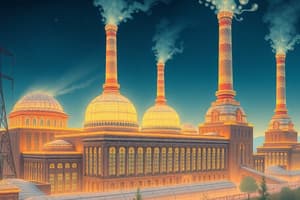Podcast
Questions and Answers
Which component of the Rankine cycle is responsible for cooling steam back into water?
Which component of the Rankine cycle is responsible for cooling steam back into water?
- Boiler
- Condenser (correct)
- Pump
- Turbine
Which type of power plant utilizes nuclear fission to produce steam in the Rankine cycle?
Which type of power plant utilizes nuclear fission to produce steam in the Rankine cycle?
- Coal-Fired Power Plants
- Natural Gas Power Plants
- Geothermal Power Plants
- Nuclear Power Plants (correct)
Which is a significant disadvantage of the Rankine cycle?
Which is a significant disadvantage of the Rankine cycle?
- High thermal efficiency
- Ability to generate large-scale electricity
- Complex operational mechanism
- Dependence on fuel prices and availability (correct)
What is one of the efficiency improvement techniques used in the Rankine cycle?
What is one of the efficiency improvement techniques used in the Rankine cycle?
Which of the following recent developments pertains to the Rankine cycle?
Which of the following recent developments pertains to the Rankine cycle?
Flashcards are hidden until you start studying
Study Notes
Rankine Cycle: Applications In Power Generation
-
Definition: The Rankine cycle is a thermodynamic cycle that converts heat into work, primarily used in power generation.
-
Main Components:
- Boiler: Heats water to produce steam.
- Turbine: Expands steam to perform mechanical work.
- Condenser: Cools steam back into water.
- Pump: Pressurizes the water to be sent back to the boiler.
-
Types of Power Plants Utilizing Rankine Cycle:
- Coal-Fired Power Plants: Burn coal to produce steam.
- Natural Gas Power Plants: Use gas turbines in combined cycle setups, where the Rankine cycle works alongside the Brayton cycle.
- Nuclear Power Plants: Utilize nuclear fission to heat water and produce steam.
- Geothermal Power Plants: Use heat from the earth to generate steam.
-
Advantages:
- High thermal efficiency compared to other cycles (e.g., Carnot cycle).
- Established technology with extensive infrastructure.
- Capable of large-scale electricity generation.
-
Disadvantages:
- Dependent on fuel prices and availability.
- Environmental concerns related to fossil fuel combustion and emissions.
- Water consumption for cooling and steam generation.
-
Efficiency Improvement Techniques:
- Regenerative Rankine Cycle: Uses extracted steam for preheating water before entering the boiler.
- Reheat Rankine Cycle: Reheats steam after partial expansion in the turbine to improve efficiency.
- Combined Heat and Power (CHP): Utilizes waste heat to enhance overall system efficiency.
-
Recent Developments:
- Integration with renewable energy sources (e.g., solar thermal).
- Advanced materials for higher temperature and pressure operations to increase efficiency.
-
Overall Impact: The Rankine cycle remains a cornerstone of modern power generation, balancing efficiency with practicality in various energy sources.
Rankine Cycle Overview
- The Rankine cycle is a thermodynamic cycle essential for converting heat into work, predominantly employed in power generation.
Main Components
- Boiler: Heats water to convert it into steam, initiating the cycle.
- Turbine: Utilizes steam expansion to generate mechanical work, often linked to electrical generation.
- Condenser: Cools and condenses the steam back into water, facilitating continuous operation.
- Pump: Pressurizes the water, preparing it for reheating in the boiler.
Types of Power Plants Utilizing Rankine Cycle
- Coal-Fired Power Plants: Generate steam by burning coal, a conventional energy source.
- Natural Gas Power Plants: Employ gas turbines in a combined cycle, harmonizing with the Brayton cycle for enhanced efficiency.
- Nuclear Power Plants: Utilize nuclear fission processes to produce steam for power generation.
- Geothermal Power Plants: Capitalize on geothermal energy for steam generation, tapping into earth's natural heat.
Advantages
- Demonstrates superior thermal efficiency over alternatives like the Carnot cycle.
- Represents established technology with extensive global infrastructure.
- Capable of producing large-scale electricity, meeting high demands.
Disadvantages
- Vulnerable to fluctuations in fuel prices and availability, posing economic risks.
- Environmental issues arise from fossil fuel combustion, leading to emissions.
- Significant water usage for cooling and steam production raises concerns in water-scarce regions.
Efficiency Improvement Techniques
- Regenerative Rankine Cycle: Enhances efficiency by preheating water using extracted steam before it enters the boiler.
- Reheat Rankine Cycle: Modifies steam after partial expansion in the turbine, further boosting efficiency.
- Combined Heat and Power (CHP): Increases overall system effectiveness by utilizing waste heat.
Recent Developments
- Integration with renewable energy sources, such as solar thermal systems, is expanding.
- Development of advanced materials designed for higher temperature and pressure operations aims to elevate cycle efficiency.
Overall Impact
- The Rankine cycle serves as a fundamental element in contemporary power generation, adeptly balancing efficiency with the practicality of various energy sources.
Studying That Suits You
Use AI to generate personalized quizzes and flashcards to suit your learning preferences.




